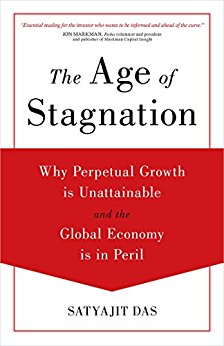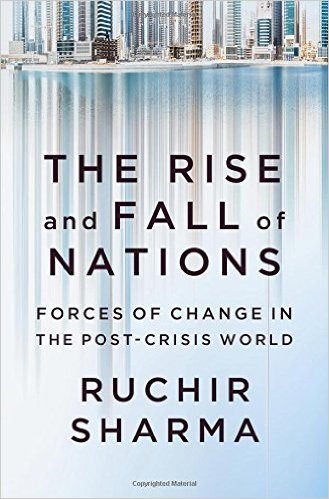I have been doing some reading this term. Here are book reviews of the books I have read so far.
The Age of Stagnation by Satyajit Das

In Age of Stagnation Satyajit Das puts forward narratives from across the world showing how long-term economic stagnation is becoming a reality of our times. He discusses how the management of the Global Financial Crisis using quantitative easing and monetary policy has twisted incentives and the nature of risk taking in financial markets in the developed world. This obviously leads to misallocation of capital and inefficiencies. He then describes other forces like an ageing population, increasing automation, and their impact on consumption, which is the major driver of traditional economic growth in the West. Then there are environmental and natural constraints that create a paradox of infinite growth in a finite world, and the changing political climate across the world which is becoming more polarized and inward looking leading what he terms as reverse globalization. He also takes a look at emerging markets and the challenges they face from debt bubbles to poverty. It serves as a good introduction to the forces of change in the post-crisis world, and makes for an interesting read.
The (Mis)Behaviour of Markets by Benoit Mandelbrot
This i s book by the great mathematician Benoit Mandelbrot is a must read for anybody, who wants to work in the financial markets. Mandelbrot has done a deep dive into understanding the behaviour of financial markets using mathematical tools he developed himself. He proposes there are patterns that markets follow and goes on to develop quantitative metrics to measure such patterns. The book as the author claims is not a silver bullet to make a huge profit in financial markets, but it does give insights like how volatility in markets tends to cluster or how one can model a price series using a few mathematical tool. He criticizes ideas in modern finance like mean-variance portfolio optimization and certain time-series techniques as they tend to underestimate risk and cannot relied upon in a complex system such as the financial markets. He introduces an interesting idea of scaling and shows how different price series regardless of their frequency (daily, monthly, annual) share similar characteristics. He also discusses the impact of price history in terms of two effects he calls the Joseph and Noah effects. I highly recommend this book to anyone who wants to understand how financial markets work and wants to invest wisely. In fact, I think it should be compulsory reading as a part of curriculum in finance alongside the typical financial theory that is taught.
s book by the great mathematician Benoit Mandelbrot is a must read for anybody, who wants to work in the financial markets. Mandelbrot has done a deep dive into understanding the behaviour of financial markets using mathematical tools he developed himself. He proposes there are patterns that markets follow and goes on to develop quantitative metrics to measure such patterns. The book as the author claims is not a silver bullet to make a huge profit in financial markets, but it does give insights like how volatility in markets tends to cluster or how one can model a price series using a few mathematical tool. He criticizes ideas in modern finance like mean-variance portfolio optimization and certain time-series techniques as they tend to underestimate risk and cannot relied upon in a complex system such as the financial markets. He introduces an interesting idea of scaling and shows how different price series regardless of their frequency (daily, monthly, annual) share similar characteristics. He also discusses the impact of price history in terms of two effects he calls the Joseph and Noah effects. I highly recommend this book to anyone who wants to understand how financial markets work and wants to invest wisely. In fact, I think it should be compulsory reading as a part of curriculum in finance alongside the typical financial theory that is taught.
The Rise and Fall of Nations by Ruchir Sharma
Ruchir Sharma a senior analyst at Morgan Stanley is known for his macroeconomic insights. His first book Breakout Nations was a bestseller, and provided a deep analysis of emerging across the world. He is now out with his second book The Rise and Fall of Nations in which he presents an analysis of various forces that shape progress in the post-crisis world. The book has ten chapters each exploring one aspect that helps to characterize progress a country has made. At the end of each chapter he provides a set of variables economic or otherwise, and a judgement heuristic associated with them. The book serves as an excellent introduction to the global economy, and the enterprising reader may even conduct their own analyses based Sharma’s insights as lot the data he uses is freely accessible through the websites various organizations.
Arrow’s Impossibility Theorem by Amartya Sen and Eric Maskin
This is short  book based on the Arrow lectures held at Columbia University. The lectures discussed in the book were delivered by economists Amartya Sen and Eric Maskin both of whom have won the Nobel Prize. The book discusses Arrow’s impossibility theorem and its consequences. It also discusses some extensions to the theorem that help develop techniques to improve social outcomes. Most of the book is highly accessible, and offers an eye opening insight into the workings of democratic societies, though the last chapter gets technical using concepts from measure theory to prove how the majority rule is stronger than any other rule in other words if one can find a rule that satisfies certain axioms (or rules) it can be shown that the majority rule satisfies them too. It is recommended for those, who are genuinely interested in the social sciences as it can be a bit formal in some places.
book based on the Arrow lectures held at Columbia University. The lectures discussed in the book were delivered by economists Amartya Sen and Eric Maskin both of whom have won the Nobel Prize. The book discusses Arrow’s impossibility theorem and its consequences. It also discusses some extensions to the theorem that help develop techniques to improve social outcomes. Most of the book is highly accessible, and offers an eye opening insight into the workings of democratic societies, though the last chapter gets technical using concepts from measure theory to prove how the majority rule is stronger than any other rule in other words if one can find a rule that satisfies certain axioms (or rules) it can be shown that the majority rule satisfies them too. It is recommended for those, who are genuinely interested in the social sciences as it can be a bit formal in some places.
Persepolis by Marjane Satrapi

Persepolis is a memoir of the author Marjane Satrapi in which she describes her life as she grew up during Islamic Revolution in Iran, her experiences during the Iran-Iraq War when she had close brushes with death, her time in Austria where she experienced a very different life and finally her return to Iran. The book is full of interesting anecdotes as she makes her way through an Iran, which is becoming increasingly conservative, and the cultural shock she faces in Austria. The book is a graphic novel beautifully illustrated by Satrapi herself. Today, Satrapi lives in Paris, and writes for The New Yorker among other publications. I highly recommend this book to anyone and everyone. Read it before you get too old!
